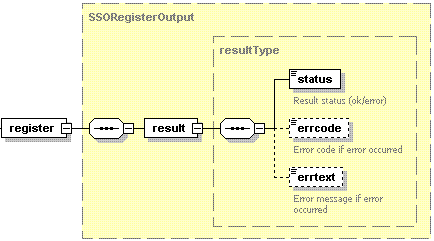Registering Plesk in IdP
Use the register operation to register Plesk in a specific IdP.
Note: To change the IdP URL, use the set-branded-idp operation. For details, refer to ...
Request Packet Structure
A request XML packet registering Plesk in a specific IdP includes the register operation node:
<packet version="1.5.2.0">
<sso>
<register>
...
</register>
</sso>
</packet>
The register node is presented by type SSORegisterInput (sso.xsd), and its graphical representation is as follows:

- The idp-url node is required. It specifies URL of the IdP. Data type: base64.
Response Packet Structure
The register node of the output XML packet is presented by type SSORegisterOutput (sso.xsd) and structured as follows:

- The result node is required. It wraps the response retrieved from the server. Data type: resultType (
common.xsd). - The status node is required. It specifies the execution status of the operation. Data type: string. Allowed values: ok | error.
- The errcode node is optional. Is returns the error code if the operation fails. Data type: integer.
- The errtext node is optional. It returns the error message if the operation fails. Data type: string.
Samples
This request packet registering Plesk in the IdP service located at http://example.com:11443/.
<packet version="1.5.2.0">
<sso>
<register>
<idp-url>aHR0cDovL2V4YW1wbGUuY29tOjExNDQzLw==</idp-url>
</register>
</sso>
</packet>Response:
<packet version="1.5.2.0">
<sso>
<register>
<result>
<status>ok</status>
</result>
</register>
</sso>
</packet>